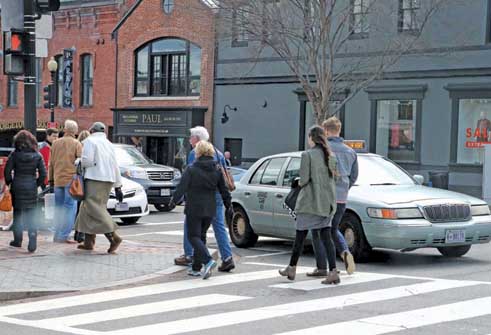Signal Timing Adjustments Coming to M Street Soon

By Brady HoltCurrent Staff Writer
Traffic signals on M Street NW in Georgetown may soon be re-timed so pedestrians don’t have to wait as long to cross, according to the D.C. Department of Transportation.
While the agency hasn’t yet determined what the new signal timing would be, spokesperson Michelle Phipps-Evans said Monday that revisions are scheduled to be in place by the end of this month.
The change follows a long-running push by the Georgetown Business Improvement District, which was joined last month by Advisory Neighborhood Commission 2E. According to the community members, pedestrians at a number of M Street intersections currently must wait for up to 90 seconds for a chance to cross. This delay frequently leads to crowds of pedestrians blocking the sidewalk as they wait.
Until about a year ago, wait times didn’t exceed 60 seconds, which ANC 2E (Georgetown, Burleith) said was an acceptable standard. The business group is seeking a maximum of 45 seconds.
But Georgetown’s pedestrian-heavy main street is also a critical east-west commuter route for cars. Accordingly, the Transportation Department last May made the move to adjust M Street’s signals as part of a broader program to ease traffic into, out of and around the city’s downtown.
“The timing changes were implemented to reduce the constant traffic congestion that has plagued the Georgetown area over the years,” Phipps-Evans wrote in an email. “Before, and even during the implementation of new timings, DDOT’s traffic signal engineers made several observations of traffic patterns (during peak hours), all the while considering the delicate balance among the multiple modes of travel in the District.”
Will Handsfield, transportation director for the Georgetown BID, said this neighborhood has its own specific needs: It’s a pedestrian-oriented shopping district with narrow sidewalks and a healthy tourist trade.
“That’s our competitive advantage,” he said. “They could go to the same stores in a number of other places. The primary part of it is that you can walk in comfort and safety. … If we don’t pay attention to that and try to protect that, we lose this thing that’s intangible, which is how special Georgetown is as a place. The specialness would probably be out-competed by areas that do take that into account.”
In a unanimous resolution passed April 4, ANC 2E prioritized three specific intersections — where M meets 30th, 31st and Thomas Jefferson streets NW. At the time, commissioner Bill Starrels said other intersections in Georgetown have also been problematic, but that these three were the worst trouble spots. He added that car traffic on the side streets is also affected.
The Georgetown BID, meanwhile, is focusing on pedestrian crossing times at all M Street intersections.
Phipps-Evans said the Transportation Department is working with the business group on the signal issue. Handsfield said he’s hopeful that the agency can develop a win-win solution.
“We think we can get all or most of the congestion-relief benefits that the city has delivered and also make it comfortable for pedestrians,” said Handsfield. “I don’t think it’s an either/or choice.”
This article appears in the May 11 issue of The Georgetown Current newspaper.




